
The euro is the official currency of 19 out of the 27 member states of the European Union. This group of states is known as the eurozone or, officially, the euro area, and includes about 349 million citizens as of 2019. The euro is divided into 100 cents.
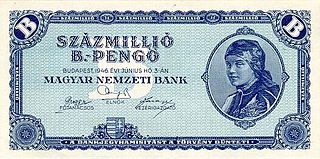
In economics, hyperinflation is a very high and typically accelerating inflation. It quickly erodes the real value of the local currency, as the prices of all goods increase. This causes people to minimize their holdings in that currency as they usually switch to more stable foreign currencies. When measured in stable foreign currencies, prices typically remain stable.
The Ithaca HOUR is a local currency formerly used in Ithaca, New York and was one of the longest-running local currency systems, though it is now no longer in circulation. It has inspired other similar systems in Madison, Wisconsin; Santa Barbara, California; Corvallis, Oregon; and a proposed system in the Lehigh Valley, Pennsylvania. One Ithaca HOUR is valued at US$10 and is generally recommended to be used as payment for one hour's work, although the rate is negotiable.
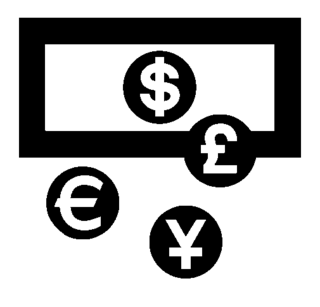
In economics, a local currency is a currency that can be spent in a particular geographical locality at participating organisations. A regional currency is a form of local currency encompassing a larger geographical area, while a community currency might be local or be used for exchange within an online community. A local currency acts as a complementary currency to a national currency, rather than replacing it, and aims to encourage spending within a local community, especially with locally owned businesses. Such currencies may not be backed by a national government nor be legal tender. About 300 complementary currencies, including local currencies, are listed in the Complementary Currency Resource Center worldwide database.

The Canadian dollar is the currency of Canada. It is abbreviated with the dollar sign $, or sometimes CA$, Can$ or C$ to distinguish it from other dollar-denominated currencies. It is divided into 100 cents (¢).
The Hong Kong dollar is the official currency of the Hong Kong Special Administrative Region. It is subdivided into 100 cents or 1000 mils. The Hong Kong Monetary Authority is the monetary authority of Hong Kong and the Hong Kong dollar.

A scrip is any substitute for legal tender. It is often a form of credit. Scrips have been created and used for a variety of reasons, including exploitive payment of employees under truck systems; or for use in local commerce at times when regular currency was unavailable, for example in remote coal towns, military bases, ships on long voyages, or occupied countries in wartime. Besides company scrip, other forms of scrip include land scrip, vouchers, token coins such as subway tokens, IOUs, arcade tokens and tickets, and points on some credit cards.
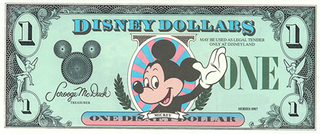
Disney Dollars is a form of corporate scrip previously sold by The Walt Disney Company and redeemable for goods or services at many Disney facilities.

Chiemgauer is a regional local currency started in 2003 in Prien am Chiemsee, Bavaria, Germany. Named after the Chiemgau, a region around the Chiemsee lake, it is intended to increase local employment, supporting local culture, and make the local food supply more resilient. The Chiemgauer operates with a fixed exchange rate, tied to the value of the euro: 1 Chiemgauer = €1.
Canadian Tire money, officially Canadian Tire 'money' or CTM, is a loyalty program operated by the Canadian retail chain Canadian Tire. It consists of coupons, issued by the company, which resemble real banknotes. It can be used as scrip in Canadian Tire stores, but is not considered a private currency. The notes are printed on paper similar to what Canadian currency was printed on when they were still paper, and were jointly produced by two of the country's long-established security printers, British American Banknote Company (BABN) and Canadian Bank Note Company (CBN). Some privately owned businesses in Canada accept CTM as payment, since the owners of many such businesses shop at Canadian Tire. In Canadian Tire stores, CTM is accepted for Canadian money at par, ie; 1 Canadian Tire Dollar = 1 Canadian Dollar.

The Confederate States dollar was first issued just before the outbreak of the American Civil War by the newly formed Confederacy. It was not backed by hard assets, but simply by a promise to pay the bearer after the war, on the prospect of Southern victory and independence. As the Civil War progressed and victory for the South seemed less and less likely, its value declined. After the Confederacy's defeat, its money had no value, and both individuals and banks lost large sums.
A private currency is a currency issued by a private entity, be it an individual, a commercial business, a nonprofit or decentralized common enterprise. It is often contrasted with fiat currency issued by governments or central banks. In many countries, the issuance of private paper currencies and/or the minting of metal coins intended to be used as currency may even be a criminal act such as in the United States. Digital cryptocurrency is sometimes treated as an asset instead of a currency. Cryptocurrency is illegal as a currency in a few countries.
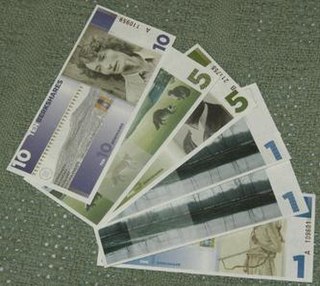
BerkShares is a local currency that circulates in The Berkshires region of Massachusetts. It was launched on September 29, 2006 by BerkShares Inc., with research and development assistance from the Schumacher Center for a New Economics. The BerkShares website lists around 400 businesses in Berkshire County that accept the currency. Since launch, over 10 million BerkShares have been issued from participating branch offices of local banks. The bills were designed by John Isaacs and were printed by Excelsior Printing on special paper with incorporated security features from Crane & Co. BerkShares are pegged with an exchange rate to the US dollar, but the Schumacher Center has discussed the possibility of pegging its value to a basket of local goods in order to insulate the local economy against volatility in the US economy.

Japanese invasion money, officially known as Southern Development Bank Notes, was currency issued by the Japanese Military Authority, as a replacement for local currency after the conquest of colonies and other states in World War II. In February 1942 in Japan, laws were passed establishing the Wartime Finance Bank and the Southern Development Bank. Both institutions issued bonds to raise funds. The former loaned money primarily to military industries, but also to a wide range of other ventures, including hydroelectric generators, electric power companies, shipbuilding and petroleum. The latter provided financial services in areas occupied by the Japanese military, and Southern Development Bank notes were in fact used as de facto military scrip. In December 1942, the outstanding balance of Southern Development Bank notes stood at more than 470 million; in March 1945, more than 13 billion.
The Totnes pound (t£) was a complementary local currency, intended to support the local economy of Totnes, a town in Devon, England. It was in circulation from March 2007 to June 2019, when it was discontinued due partly to an increasingly cashless economy.

Hyperinflation in Zimbabwe is an ongoing period of currency instability in Zimbabwe that, using Cagan's definition of hyperinflation, began in February 2007. During the height of inflation from 2008 to 2009, it was difficult to measure Zimbabwe's hyperinflation because the government of Zimbabwe stopped filing official inflation statistics. However, Zimbabwe's peak month of inflation is estimated at 79.6 billion percent month-on-month, 89.7 sextillion percent year-on-year in mid-November 2008.
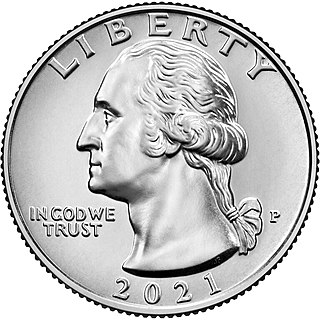
The United States dollar is the official currency of the United States and several other countries. The Coinage Act of 1792 introduced the U.S. dollar at par with the Spanish silver dollar, divided it into 100 cents, and authorized the minting of coins denominated in dollars and cents. U.S. banknotes are issued in the form of Federal Reserve Notes, popularly called greenbacks due to their predominantly green color.
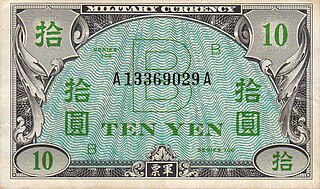
B yen was a colloquial term used to refer to a form of military scrip used in post-war US-Occupied Okinawa from April 15, 1946, to September 1958. Officially, it was called B type military scrip.
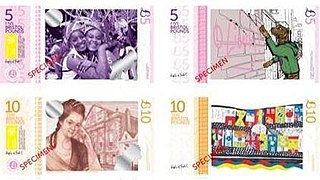
The Bristol pound (£B) is a form of local, complementary, and/or community currency launched in Bristol, UK on 19 September 2012. Its objective is to encourage people to spend their money with local, independent businesses in Bristol, and for those businesses to in turn localise their own supply chains. At the point of the close of the digital scheme in August 2020, it was the largest alternative in the UK to official sterling currency, and is backed by sterling.

The United States two-dollar bill ($2) is a current denomination of United States currency. A portrait of Thomas Jefferson, the third president of the United States (1801–1809), is featured on the obverse of the note. The reverse features an engraving of the c. 1818 painting Declaration of Independence by John Trumbull.















